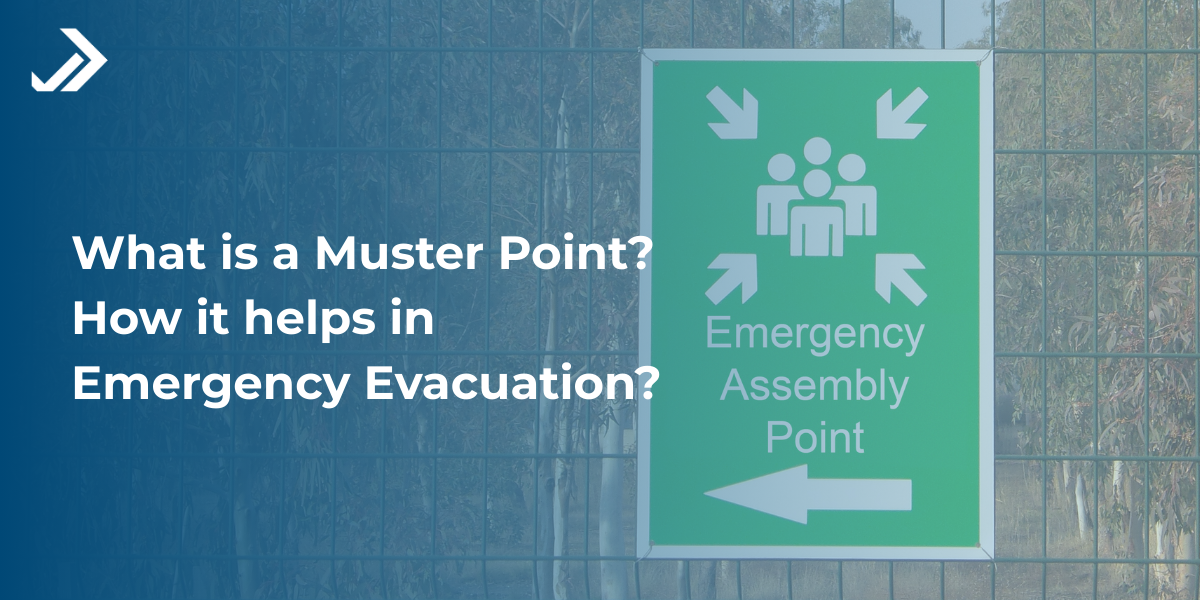

Author : Marcom Team | Follow us on LinkedIn:
14 Aug, 2024
What is a Muster Point? How it helps in Emergency Evacuation?
Table of Contents
In any environment, whether it’s a workplace, school, or public venue, safety is a paramount concern. Emergencies can occur unexpectedly, and having a well-defined plan for such situations is essential to protect everyone involved. A critical component of any emergency plan is ensuring that all individuals can quickly and safely evacuate the area and be accounted for. This is where the concept of a muster point comes into play.
What is a Muster Point?
A muster point is a safe location designated for individuals to gather during an emergency evacuation. The primary purpose is to facilitate an organized evacuation, enabling emergency responders to conduct headcounts and provide necessary assistance. Muster points should be easily accessible and clearly marked, typically located in open areas away from the building. Additionally, they must be large enough to accommodate all evacuees and provide a safe distance from potential hazards.
Benefits of Muster Point Configuration
Muster points offer several key benefits during emergencies, enhancing the overall safety and efficiency of evacuation processes. Here are the main advantages:
Ensures Accountability:
Muster points allow for a quick and accurate headcount, ensuring that all individuals are accounted for after an evacuation. This helps emergency personnel identify if anyone is missing and may need assistance.
Streamlines Communication:
In an emergency, clear communication is critical. Muster points provide a central location where information can be disseminated to everyone, reducing confusion and panic.
Facilitates Organized Evacuation:
By directing everyone to a predetermined location, muster points help prevent chaos during evacuations. This organized approach reduces the risk of injury and ensures that evacuation procedures are followed correctly.
Enhances Emergency Response:
Emergency responders can more effectively assist and coordinate their efforts when people are gathered at a muster point. It helps them focus their search and rescue efforts on areas where people might still be trapped.
Improves Safety Planning:
The existence of muster points is a key element in safety drills and emergency planning. Regularly practicing gathering at these points helps familiarize everyone with evacuation procedures, increasing the chances of a smooth and successful response during a real emergency.
Reduces Panic:
Knowing that there is a safe, designated place to go in an emergency can reduce panic and anxiety among individuals. This reassurance helps maintain order and calm during stressful situations.
Supports Legal and Regulatory Compliance:
Many industries and organizations are required by law to have muster points as part of their emergency preparedness plans. Having these points in place ensures compliance with safety regulations and standards.
Key Considerations for Configuring Muster Points
When installing a muster point, several key considerations should be taken into account to ensure its effectiveness and safety. Here are the primary factors to consider:
Location:
The muster point should be located a safe distance from the building or area of potential danger, such as fire hazards, falling debris, or hazardous materials. It should be far enough to avoid these risks but close enough for individuals to reach quickly.
Visibility and Signage:
The muster point must be clearly marked with visible signage that is easy to spot from various locations within the facility. Signs should be reflective or illuminated, ensuring they are visible even in low light or smoky conditions.
Accessibility:
Ensure that the route to the muster point is free from obstacles and easy to navigate, even in an emergency.
Capacity:
The muster point should be large enough to accommodate the maximum number of people who might need to gather there. Consider the size of the workforce or population using the facility, and ensure there is sufficient space for everyone to gather safely.
Proximity to Emergency Services:
Ideally, the muster point should be located where emergency services can easily reach it. This facilitates quicker assistance if someone requires medical attention or other help.
Multiple Muster Points:
In large facilities or sites, having multiple muster points can prevent overcrowding and ensure that everyone can evacuate to a safe location quickly. Each muster point should be strategically placed to serve different areas of the facility.
Communication Tools:
Ensure that communication tools, such as radios or phones, are available at or near the muster point to relay information to emergency responders or coordinate further actions.
Weather Considerations:
In outdoor muster points, consider the impact of weather conditions. If possible, provide some form of shelter or protection from the elements.
Regular Maintenance and Inspection:
The muster point and its signage should be inspected regularly to ensure it functionality and visibility. This requires examining for potential wear and damage on signs, clearing any obstacles, and verifying that the area remains safe.
Integration with Emergency Plans:
The muster point should be integrated into the overall emergency plan of the facility. Regular drills should be conducted to ensure that everyone knows where to go and what to do during an evacuation.
Coordination with Neighboring Sites:
If the facility is located near other businesses or facilities, coordinate with them to ensure that muster points do not overlap and cause confusion during an emergency.
The Role of Muster Point in Access Control System
Integrating muster points with an access control system can enhance emergency management by providing real-time information, improving safety, and ensuring more efficient evacuations. Here’s how this integration can be achieved:
Automated Headcount and Accountability:
Equip muster points with access control readers where employees and visitors can scan their ID badges upon arrival. The system can automatically track who has reached the muster point, providing a real-time headcount and identifying any missing individuals. The system can feed data into a centralized dashboard, allowing emergency personnel to monitor who has checked in at the muster point. This helps quickly identify anyone who may still be inside the building or who has not yet reached safety.
Integration with Evacuation Alarms:
In the event of an emergency, the access control system can automatically unlock specific doors to facilitate evacuation, guiding people toward muster points. Simultaneously, it can restrict access to hazardous areas.The system can also send alerts on SMS, email, or public address systems, directing individuals to the nearest muster point and providing instructions on how to reach it safely.
Data Analytics and Reporting:
After an emergency, the access control system can generate detailed reports on who was present, who evacuated, and who might have been left behind. This data is valuable for post-incident analysis and improving future emergency protocols. The integration can provide an audit trail to demonstrate compliance with safety regulations, showing that all personnel were accounted for during an evacuation.
Conclusion
In conclusion, muster points are a vital component of emergency evacuation plans. Proper configuration and integration with access control systems enhance safety, ensure accurate headcounts, and reduce chaos during emergencies. By prioritizing the establishment and upkeep of muster points, organizations can greatly enhance their emergency preparedness and response capabilities.








